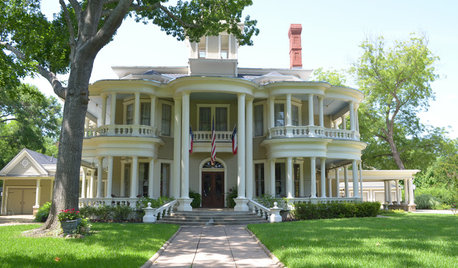Tom Brown
Poorbutroserich Susan Nashville
10 years ago
Related Stories

KITCHEN DESIGNA Contemporary Kitchen With French Cafe Flavor
Interior designer Tom Long gets creative with materials to build a custom kitchen with a dash of old-school French charm
Full Story
HOUZZ TOURSHouzz Tour: A Modern Mountain Home Takes Off With Its Own Airstrip
In Colorado, a glass and concrete home hugs a former hayfield that’s now a launching pad for antique planes
Full Story
TRADITIONAL HOMESMy Houzz: Step Inside a Grand 1800s Victorian
A 7,000-square-foot historic estate returns to glory, thanks to loving renovations by a tireless Texas couple
Full Story
DECORATING STYLESIs Your Home Ready for a 1970s Revival?
Seventies chic is a trend that’s been brewing for some time, but this year it could hit big — with a few modern tweaks
Full Story
HOUZZ TOURSMy Houzz: Copper Tones Warm an Amsterdam Apartment
Paint, editing and a crush on copper help an Amsterdam resident conquer his compact space
Full Story
KITCHEN OF THE WEEKKitchen of the Week: Fans of Traditional Style Go For a ‘Mad Men’ Look
The TV show inspires a couple to turn their back on the style they knew and embrace a more fun and funkier vibe in their kitchen
Full Story
TRANSITIONAL HOMESMy Houzz: Australian Family Builds Its ‘20-Year House’
Designing from scratch enables a Melbourne couple to create a home their kids can grow up in
Full Story
ROOM OF THE DAYRoom of the Day: New Life for Historic Wallpaper Landscapes
In a Rhode Island mansion, painstaking restoration saves lavish woodblock-printed paper scenes commissioned in the early 1800s
Full Story
KITCHEN OF THE WEEKKitchen of the Week: Good Flow for a Well-Detailed Chicago Kitchen
A smart floor plan and a timeless look create an inviting kitchen in a narrow space for a newly married couple
Full Story
ARCHITECTUREDouble Take: Moorish Goes Modern in a Manhattan Townhouse
A Moroccan screen inspired by an ancient pattern takes high-tech effort, with stunning results
Full Story










roseseek
Poorbutroserich Susan NashvilleOriginal Author
Related Professionals
La Marque Landscape Architects & Landscape Designers · Roxbury Crossing Landscape Architects & Landscape Designers · Wake Forest Landscape Contractors · Surprise Landscape Contractors · Indianapolis Landscape Contractors · Midland Landscape Contractors · South Hackensack Landscape Contractors · Jacksonville Swimming Pool Builders · Redlands Swimming Pool Builders · Rowlett Swimming Pool Builders · Germantown Siding & Exteriors · Linden Siding & Exteriors · Pike Creek Valley Siding & Exteriors · Rockville Siding & Exteriors · North Richland Hills Siding & Exteriorsroseseek
Poorbutroserich Susan NashvilleOriginal Author
odinthor
roseseek
odinthor
Poorbutroserich Susan NashvilleOriginal Author
roseseek
cath41
Poorbutroserich Susan NashvilleOriginal Author
roseseek
erasmus_gw
roseseek
roseseek
ms. violet grey
ms. violet grey
nippstress - zone 5 Nebraska
roseseek
ms. violet grey
roseseek
ms. violet grey
ms. violet grey
Poorbutroserich Susan NashvilleOriginal Author
ms. violet grey
Poorbutroserich Susan NashvilleOriginal Author